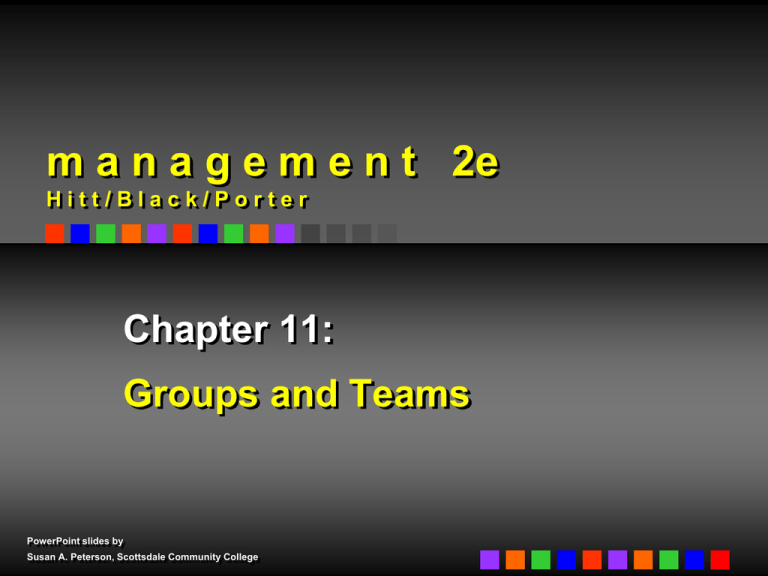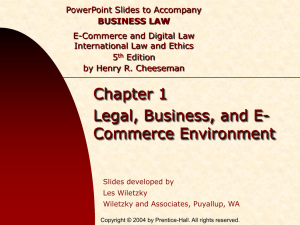Management Theories on Groups on Teams
advertisement

m a n a g e m e n t 2e Hitt/Black/Porter Chapter 11: Groups and Teams PowerPoint slides by Susan A. Peterson, Scottsdale Community College Learning Objectives After studying this chapter, you should be able to: Describe the similarities and differences between groups and teams Identify and compare different types of groups Name the factors that influence group formation and development Analyze the various structural and behavioral characteristics of groups © 2008 Prentice-Hall Business Publishing 2 Learning Objectives Identify the advantages and disadvantages of selfmanaging, cross-functional, global and virtual work groups and team Explain the differences in the various types of team competencies Distinguish between the two major types of group conflict, and discuss their causes and consequences Explain how managers can help their work groups develop into high performing teams © 2008 Prentice-Hall Business Publishing 3 Group versus Team Group Team A set of people, usually from 3 to 20 Some degree of interaction and shared objectives A type or form of group vs. Higher degree of coordinated interaction Stronger sense of members’ personal responsibility for achieving specified group outcomes High level of members’ identification with the group © 2008 Prentice-Hall Business Publishing 4 Commonality of Goal Individuals to Group-to-Group Team Continuum Team Group Individuals TEAMS demonstrate enhanced: Coordinated interaction Personal responsibility for group outcomes Individual identification with group Degree of Interdependence and Collaboration Adapted from Exhibit 11.1 © 2008 Prentice-Hall Business Publishing 5 Basic Types of Groups Type of Group Features Command/ Supervisory Examples One supervisor with a number of subordinates Relatively enduring Clerical units Manufacturing assembly units Membership changes relatively slowly Local sales managers reporting to a regional sales manager Project/ Temporary Product design teams Task Force Specific limited purpose Management information systems teams to develop upgraded computer systems Group members are aware of temporary nature of the group Team project groups in university classes Adapted from Exhibit 11.2 © 2008 Prentice-Hall Business Publishing 6 Basic Types of Groups (cont.) Type of Group Features Committee Examples Either permanent or ad hoc Budget committees Meet only periodically Safety committees Members have different permanent jobs and/or supervisors Promotion review committees Membership typically does not represent an employee’s highest commitment Adapted from Exhibit 11.2 © 2008 Prentice-Hall Business Publishing 7 Examples of Committees Governance Compensation Overnight Executive Finance Audit Steering Safety Ethics Disaster planning Long-range planning Public relations Adapted from Exhibit 11.3 © 2008 Prentice-Hall Business Publishing 8 Basic Types of Groups (cont.) Type of Group Features Informal Group not originated by the organization Voluntary membership Obvious differences and boundaries between members and nonmembers Examples Group of employees who lunch together on Fridays Van pool group The “water cooler group” Adapted from Exhibit 11.2 © 2008 Prentice-Hall Business Publishing 9 What Influences the Formation of Groups and Teams? Organizational goals - How does the group fit into the larger organization’s goals? Opportunities for interaction and sharing mutual knowledge - Groups can meet face-to-face or virtually Psychological factors - Security needs, social support, self-esteem needs, status needs © 2008 Prentice-Hall Business Publishing 10 Formation and Development of Groups and Teams Forming Storming Norming Performing Indicates progression Adapted from Exhibit 11.4 © 2008 Prentice-Hall Business Publishing 11 Structural Characteristics of Groups and Teams Size Composition Differentiated roles Differentiated status © 2008 Prentice-Hall Business Publishing 12 Structural Characteristics of Groups and Teams Size - Social loafing: the phenomenon of reduced effort per person in large groups - Process costs: increasing costs of coordination as group size increases Composition - Homogeneous - Heterogeneous or diverse © 2008 Prentice-Hall Business Publishing 13 Examples of Diversity within Groups and Potential Consequences Types of Diversity Potential Consequences Observable Attributes Race Ethnicity Gender Age Affective Consequences Satisfaction Identification with the group Conflict within the group Underlying Attributes Values Skills Knowledge and information Tenure Cognitive Consequences Innovation Amount and quality of new ideas Communication-Related Consequences Decreased frequency within the group Increased frequency outside the group Adapted from Exhibit 11.5 © 2008 Prentice-Hall Business Publishing 14 Structural Characteristics of Groups and Teams Differentiated roles - Role ambiguity: the expected behaviors for a group member are not clearly defined - Role conflict: a group member faces two or more contrasting sets of expectations Differentiated status - Status: prestige that a person has in a group © 2008 Prentice-Hall Business Publishing 15 Behavioral Characteristics of Groups and Teams Norms Cohesiveness © 2008 Prentice-Hall Business Publishing 16 Behavioral Characteristics of Groups and Teams Norms: a group’s shared standards that guide the behavior of its individual members Characteristics of group norms - Established for important issues - Some apply only to certain members - Vary in degree of acceptance - Vary in how much deviation members are permitted © 2008 Prentice-Hall Business Publishing 17 Development of Group Norms Members agree on behavior Group members meet Members observe the behavior of others to determine what is appropriate Members decide if any past experience can contribute effective behaviors Members disagree on behavior Norm is established Suggested behavior is tolerated even though disagree with Dissenting member withdraws from group New behavior is suggested Adapted from Exhibit 11.6 © 2008 Prentice-Hall Business Publishing 18 Behavioral Characteristics of Groups and Teams Development of group norms Early behaviors - First behaviors exhibited by members Imported behaviors - Brought by members from previous groups Effects of group norms Critical events - A sudden challenge to the group, such as a crisis © 2008 Prentice-Hall Business Publishing Conformity: close adherence to the group’s norms by the individual members 19 Behavioral Characteristics of Groups and Teams Cohesion – the degree to which members are motivated to remain in the group Group cohesion Strengthens interpersonal attraction among group members Generates a record of high performance and past success of the group Fosters competition with other groups © 2008 Prentice-Hall Business Publishing 20 Effects of Group Cohesion Positive effects Negative effects Increased quality and quantity of group interactions Strengthened adherence to group norms Increased effectiveness in achieving group goals Augmented individual satisfaction with group membership Useful or creative ideas may be ignored if they deviate from established norms or values Increased probability of developing groupthink Potential decrease in intergroup cooperation Counterproductive norms may be emphasized Adapted from Exhibit 11.7 © 2008 Prentice-Hall Business Publishing 21 Prominent Groups and Teams in Today’s Organizations Type Potential Advantages Potential Disadvantages Self-Managing More team-like behavior Not all employees want to manage themselves CrossFunctional/ New Product Increased creativity Dispersed knowledge Speed to market Increased group conflict Global Increased creativity from diversity of backgrounds Paralysis Inaction Failure Virtual Increased speed of communication Decreased costs Increased misinterpretation Lack of trust Difficult to manage Adapted from Exhibit 11.8 © 2008 Prentice-Hall Business Publishing 22 Team Competencies Knowledge Knowledge of team mission, objectives, norms Task sequencing Team role Interaction patterns Understanding team work skills Teammate characteristics Skills Attitudes Adaptability and flexibility Team orientation Mutual performance monitoring and feedback, selfcorrection Team cohesion Coordination and task integration Shared vision Mutual trust Importance of teamwork Communication Decision making and problem solving Adapted from Exhibit 11.9 © 2008 Prentice-Hall Business Publishing 23 Dealing with Team Conflict Task (substantive): conflict conflict that focuses on differences in ideas and courses of action in addressing the issues facing a group Relationship (affective) conflict: interpersonal differences among group members © 2008 Prentice-Hall Business Publishing 24 Dealing with Team Conflict Type of Conflict: Description: Task Differences in ideas and courses of action in addressing the issues facing a group. Process Differences of opinion about the procedures to be used by the group to achieve its goals. Relationship Interpersonal differences among group members. © 2008 Prentice-Hall Business Publishing 25 Dealing with Team Conflict (cont.) Type of Conflict: Caused by: Task and Process Ambiguities regarding the task Differences in goals, objectives, and perspectives among group members Scarcity (actual or perceived) of resources to accomplish the group’s goals Relationship Dissimilarities in the composition of the membership of the group Differences in the interpersonal styles of individual members Differences in values © 2008 Prentice-Hall Business Publishing 26 Dealing with Team Conflict To manage intragroup conflict: Increase the ratio of substantive to relationship conflict Clarify and reduce task ambiguities Get the group to focus on goals that emphasize the common interests of all group members Avoid relationship conflicts © 2008 Prentice-Hall Business Publishing 27 Dealing with Team Conflict To manage intergroup conflict: Reduce unnecessary relational conflicts in intergroup interaction situations Increase the focus on substantive differences Emphasize organization-wide goals to increase cooperation and performance © 2008 Prentice-Hall Business Publishing 28 Characteristics of Highly Effective Groups Any product or service they develop is highly desired and valued by customers Increased cooperation among members is encouraged and achieved Group membership increases individual members’ feelings of satisfaction, personal growth, and overall wellbeing Adapted from Exhibit 11.10 Adapted from Exhibit 13.11: Characteristics of Highly Effective Groups © 2008 Prentice-Hall Business Publishing 29 Ingredients Necessary for Group Effectiveness For a group to operate effectively, it must: Exert enough effort to accomplish its tasks at acceptable levels of quantity and quality Obtain sufficient knowledge and skills to carry out its work Use appropriate strategies to apply its effort, knowledge, and skills effectively © 2008 Prentice-Hall Business Publishing 30 Managers’ Responsibilities for Encouraging Group Effectiveness Develop appropriate group structures Develop appropriate support from the organization Obtain appropriate coaching and consultation assistance Adapted from Exhibit 11.11 © 2008 Prentice-Hall Business Publishing 31 Checklist for Leadership of Groups How well do you: Encourage members to learn from each other? Recognize and praise members for their contributions? Keep key people outside the [group] informed about its accomplishments? Promptly inform members about major developments that [may] affect them? Give [group] members authority to make [at least some] important decisions? Adapted from Exhibit 11.12 © 2008 Prentice-Hall Business Publishing 32 Checklist for Leadership of Groups (cont.) How well do you: Openly accept and respond to feedback from [group] members? Review the [group’s] performance at the end of major tasks? Offer specific and concrete suggestions for how members can improve? Understand what motivates members to work hard? Adapted from Exhibit 11.12 © 2008 Prentice-Hall Business Publishing 33











